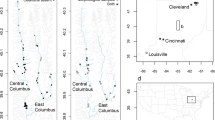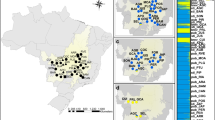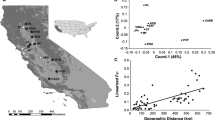Abstract
Dandelions (Taraxacum officinale Weber(sensu lato); Asteraceae) have been introduced to NorthandSouth America with human migration from Europe. While potential sourcepopulations have both sexually and obligate asexually (agamospermous)reproducing lineages, apparently only the latter have successfully colonizedtheAmericas. The consequences of obligate agamospermy on dandelion populationgenetic diversity in North America remain little explored. Here we use fourdifferent synthetic DNA probes that reveal genetic markers at multiplevariable-number-tandem-repeat (VNTR) loci to examine patterns of geneticvariation among plants collected along three different central North Americantransects with plants (21 to 22 individuals per transect) separated by: 1) >2 m and < 60 m (short transect); 2) > 5km and < 30 km (medium transect); and 3) > 30km and < 340 km (long transect). The mean numberofVNTR markers revealed per plant was 59.3. Co-clonal individuals (proportion ofbands shared exceeding 90%) were found in each transect, with the indexof clonality (the percent of co-clonal individuals detected in a transect)ranging from 34.12% for the short transect to 18.65% for the longtransect. Co-clonal individuals were separated by up to 200 km.With redundant examples of co-clonal individuals removed, mean similarity(proportion of band sharing) of distinct genotypes within transects was 0.426,and no statistical differences in level of similarity between transects, norindication of genetic differentiation between transects, was detected (meanFst between transect levels with all individuals included =0.05). These results indicate: 1) that dandelion genetic diversity ofcolonizinglineages in central North America is moderately high and does not reflectextreme bottleneck effects shown by some colonizing species; and 2) thatdandelion seed dispersal can be very effective in maintaining similar levels ofgenetic diversity at the different scales of sampling in this study, withcertain clones maintaining numerous, widespread individuals. Evidence that VNTRmutation is detectable within dandelion clonal lineages is presented,demonstrating that “clonal families” with lines increasinglydifferentiated from one another will continually evolve, and that Muller'srachet is, in all likelihood, turning for asexual lines.
Similar content being viewed by others
References
Alberte R.S., Suba G.K., Procaccini G., Zimmerman R.C. and Fain S.R. 1994. Assessment of genetic diversity of seagrass populations using DNA fingerprinting: implications for populations stability and management. Proceedings of the National Academy of Sciences, USA 91: 1049–1053.
Barrett S.C.H. 1992. Genetics of weed invasions. In: Jain S.K. and Botsford L.W. (eds), Applied Population Biology. Kluwer Academic Publishers, Netherlands, pp. 91–119.
Battjes J., Menken S.B.J. and Den Nijs J.C.M. 1992. Clonal diversity in some microspecies of Taraxacum sect. Palustria (Lind. fil.) Dahlst from Czechoslovakia. Botanische Jahrbucher für Systematik 114: 315–328.
Brown A.D.H. and Marshall D.R. 1981. Evolutionary changes accompanying colonization in plants. In: Scudder G.E. and Reveal J.L. (eds), Colonization, Succession and Stability. Blackwell Scientific Publications, Oxford, pp. 351–363.
Busemeyer D., Pelikan S., Kennedy R.S. and Rogstad S.H. 1997. Genetic diversity of Philippine Rubus moluccanus L. (Rosaceae) populations examined with VNTR DNA probes. Journal of Tropical Ecology 13: 867–884.
Diggle P.K., Lower S. and Ranker T.A. 1998. Clonal diversity in alpine populations of Polygonum viviparum (Polygonaceae). International Journal of Plant Science 159: 606–615.
Ellstrand N.C. and Roose M.L. 1987. Patterns of genotypic diversity in clonal plant species. American Journal of Botany 74: 123–131.
Falque M., Keurentjes J., Bakx-Schotman J.M.T. and van Dijk P.J. 1998. Development and characterization of microsatellite markers in the sexual-apomictic complex Taraxacum officinale (dandelion). Theoretical and Applied Genetics 97: 283–292.
Ford H. 1981. Competitive relationships amongst apomictic dandelions. Biological Journal of the Linnean Society 15: 355–368.
Frede S.E. 1995. An examination of genetic variation in spicebush (Lindera benzoin (L.) Blume; Lauraceae).
Gornall R.J. 1999. Population genetic structure in agamospermous plants. In: Hollingsworth P.M., Bateman R.M. and Gornall R.J. (eds), Molecular Systematics and Plant Evolution. Taylor & Francis, London, pp. 118–138.
Grant V.E. 1981. Plant speciation. 2nd edn. Columbia University Press, New York.
Hamilton M.B. 1997. Genetic fingerprint-inferred population subdivision and spatial genetic tests for isolation by distance and adaptation in the coastal plant Limonium carolinianum. Evolution 51: 1457–1468.
Hamrick J.L. 1989. Isozymes and the analysis of genetic structure in plant populations. In: Soltis D.E. and Soltis P.S. (eds), Isozymes in Plant Biology. Dioscorides Press, Portland, pp. 87–105.
Hughes J. and Richards A.J. 1988. The genetic structure of populations of sexual and asexual Taraxacum (dandelions). Heredity 60: 161–171.
Keane B., Lim H.W. and Rogstad S.H. 2000. Reprobing DNA blots: wet is better than dry storage of uncharged nylon membranes after removing probes. Plant Molecular Biology Reporter 18: 17–21.
Keane B., Pelikan S., Toth G.P., Smith M.K. and Rogstad S.H. 1999. Genetic diversity of Typha latifolia (Typhaceae) and the impact of pollutants examined with tandem-repetitive DNA probes. American Journal of Botany 86: 1226–1238.
Keane B., Smith M.K. and Rogstad S.H. 1998. Genetic variation in red raspberries (Rubus idaeus L.; Rosaceae) from sites differing in organic pollutants compared with synthetic tandem repeat DNA probes. Environmental Toxicology and Chemistry 17: 2027–2034.
King L.M. 1993. Origins of genotypic variation in North American dandelions inferred from ribosomal DNA and chloroplast DNA restriction enzyme analysis. Evolution 47: 136–151.
King L.M. and Schaal B.A. 1990. Genotypic variation within asexual lineages of Taraxacum officinale. Proceedings of the National Academy of Science U.S.A. 87: 998–1002.
Kirschner J. and Štěpánek J. 1994. Clonality as part of the evolution process in Taraxacum. Folia Geobotanica & Phytotaxonomica, Praha 29: 265–275.
Kumar A. and Rogstad S.H. 1998. A hierarchical analysis of mini-satellite DNA diversity in Gambel oak (Quercus gambelii Nutt.; Fagaceae). Molecular Ecology 7: 859–869.
Lim H.W. 2000. Analyses of genetic variation in Aesculus (Hippocastanaceae) using VNTR multilocus probes.
Lyman J.C. and Ellstrand N.C. 1984. Clonal diversity in Taraxacum officinale (Compositae), and apomict. Heredity 53: 1–10.
Lyman J.C. and Ellstrand N.C. 1998. Relative contribution of breeding system and endemism to genotypic diversity: the outcrossing endemic Taraxacum californicum vs. the widespread apomict T. officinale (sensu lato). Madrono 45: 283–289.
Lynch M. 1991. Analysis of population genetic structure by DNA fingerprinting. In: Burke T., Dolf G., Jeffreys A.J. and Wolff R. (eds), DNA Fingerprinting: Approaches and Applications. Birkhauser Verlag, Basel, pp. 113–126.
Menken S.B.J., Smit E. and Den Nijs H.(J.). 1995. Genetical population structure in plants: gene flow between diploid sexual and triploid asexual dandelions (Taraxacum section Ruderalia). Evolution 49: 1108–1118.
Nybom H. and Rogstad S.H. 1990. DNA fingerprints detect genetic variation in Acer negundo (Aceraceae). Plant Systematics & Evolution 173: 49–56.
Popescu I. 1999. Analyses of heterozygosity and fitness in jewelweeds (Impatiens spp.; Balsaminaceae) using VNTR multilocus probes.
Radford A.E., Ahles H.E. and Bell C.R. 1964. Manual of the vascular flora of the Carolinas. The University of North Carolina Press, Chapel Hill.
Richards A.J. 1973. The origin of Taraxacum agamospecies. Botanical Journal of the Linnaean Society 66: 189–211.
Richards A.J. 1986. Plant Breeding Systems. George Allen & Unwin, London.
Rogstad S.H. 1993. Surveying plant genomes for variable number of tandem repeats loci. Methods in Enzymology 224: 278–294.
Rogstad S.H. 1994. Inheritance in turnip of variable-number tandem-repeat genetic markers revealed with synthetic repetitive DNA probes. Theoretical and Applied Genetics 89: 824–830.
Rogstad S.H. 1996. Assessing genetic diversity in plants with synthetic tandem repetitive DNA probes. In: Gustafson J.P. and Flavell R.B. (eds), Genomes of plants and animals: 21st Stadler genetics symposium. Plenum Press, New York, pp. 1–14.
Rogstad S.H., Nybom H. and Schaal B.A. 1991. The tetrapod “DNA fingerprinting” M13 repeat probe reveals genetic diversity and clonal growth in quaking aspen (Populus tremuloides, Salicaceae). Plant Systematics & Evolution 175: 115–123.
Rogstad S.H. and Pelikan S. 1996. GELSTATS: a computer program for population genetics analyses using VNTR multilocus probe data. BioTechniques 21: 1128–1131.
Sambrook J., Fritsch E.F. and Maniatis T. 1989. Molecular Cloning. Cold Spring Harbor Laboratory Press, Cold Spring Harbour, NY.
Schartl M., Nanda I., Schlupp I., Wilde B., Epplen J., Schmid M. et al. 1995. Incorporation of subgenomic amounts of DNA as compensation for mutational load in a gynogenetic fish. Nature 373.
Solbrig O.T. 1971. The population biology of dandelions. American Scientist 59: 686–694.
Solbrig O.T. and Simpson B.B. 1977. A garden experiment on competition between biotypes of the common dandelion (Taraxacum officinale). Journal of Ecology 65: 427–430.
van der Hulst R.G.M., Mes T.H.M., den Nijs J.C.M. and Bachmann K. 2000. Amplified fragment length polymorphism (AFLP) markers reveal that population structure of triploid dandelions (Taraxacum officinale) exhibits both clonality and recombination. Molecular Ecology 9: 1–8.
van Heusden A.W., Rouppe v.d.Voort J. and Bachmann K. 1991. Oligo-(GATA) fingerprints identify clones in asexual dandelions (Taraxacum, Asteraceae). Fingerprint News 3: 13–15.
Van Oostrum H., Sterk A.A. and Wijsman H.J.W. 1985. Genetic variation in agamospermous microspecies of Taraxacum sect. Erythrosperma and sect. Obliqua. Heredity 55: 223–228.
Vavrek M.C., McGraw J.B. and Yang H.S. 1996. Within-population variation in demography of Taraxacum officinale: maintenance of genetic diverstiy. Ecology 77: 2098–2107.
Vavrek M.C. 1998. Within-population genetic diversity of Taraxacum officinale (Asteraceae): differential genotype response and effect on interspecific competition. American Journal of Botany 85: 947–954.
Weber W.A. 1990. Colorado Flora: Eastern Slope. University Press of Colorado, Niwot.
Welham C.V.J. and Setter R.A. 1998. Comparison of size-dependent reproductive effort in two dandelion (Taraxacum officinale) populations. Canadian Journal of Botany 76: 166–173.
Widen B., Cronberg N. and Widen M. 1994. Genotypic diversity, molecular markers and spatial distribution of genets in clonal plants, a literature survey. Folia Geobotanica & Phytotaxonomica, Praha 29: 245–263.
Wolff K., Rogstad S.H. and Schaal B.A. 1994. Population and species variation of minisatellite DNA in Plantago. Theoretical and Applied Genetics 87: 733–740.
Author information
Authors and Affiliations
Rights and permissions
About this article
Cite this article
Rogstad, S.H., Keane, B. & Beresh, J. Genetic variation across VNTR loci in central North American Taraxacum surveyed at different spatial scales. Plant Ecology 161, 111–121 (2002). https://doi.org/10.1023/A:1020301011283
Issue Date:
DOI: https://doi.org/10.1023/A:1020301011283




